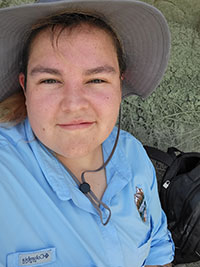 Deanna Flores. Department of Earth Sciences, 100 Cascade Hall, 1272 University of Oregon Eugene, OR 97403, USA. dflores9@uoregon.edu
Deanna Flores. Department of Earth Sciences, 100 Cascade Hall, 1272 University of Oregon Eugene, OR 97403, USA. dflores9@uoregon.edu
I am a PhD student under Dr. Samantha Hopkins at the University of Oregon. I have conducted research since I was an undergraduate at North Carolina State University where I earned my bachelor's. I moved to continue with my education at Sam Houston State University where I studied a local Pleistocene site called McFaddin Beach and earned my master's degree.
![]()
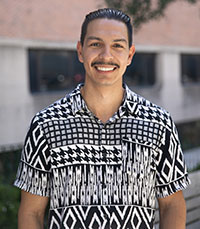 Antonio Meza. School of Life Sciences, Arizona State University, 427 East Tyler Mall, Tempe, AZ 85287, USA. ameza36@asu.edu
Antonio Meza. School of Life Sciences, Arizona State University, 427 East Tyler Mall, Tempe, AZ 85287, USA. ameza36@asu.edu
My name is Antonio Meza. I am a second year Biology PhD student at ASU. My research career began at NC State University, where I completed my Bachelor's in Zoology. During this time, I worked on the digital visualization of the mimetic musculature of lemurs. I then moved to Huntsville, Texas where I completed my Master's in Biology at Sam Houston State University. I documented the cranial variation of the amphisbaenian genus Zygaspis, contributing more comparable material and finding potential apomorphies in some of the species. After graduation, I moved to Austin, Texas to work as a research technician in Dr. Melissa Kemp's lab where I digitally segmented out cranial elements of anole lizards and placed landmarks on the rendered specimen models. Now, at ASU, I am researching the morphological variation of the Sceloporus jaw, specifically how it has changed throughout time and among sympatric congeners.
![]()
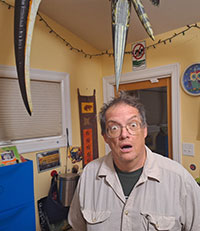 Christopher J. Bell. Jackson School of Geosciences, The University of Texas at Austin, Austin, Texas 78712, USA. cjbell@jsg.utexas.edu
Christopher J. Bell. Jackson School of Geosciences, The University of Texas at Austin, Austin, Texas 78712, USA. cjbell@jsg.utexas.edu
Dr. Bell's research centers on understanding the complex dynamics of vertebrate faunal communities during the Quaternary Period. Chris is interested in investigating patterns of vertebrate evolution, biodiversity and biogeography throughout the Quaternary, and the responses of different vertebrate groups to the various changes in climate that took place during the last two million years. Two major current research areas are: 1) the study of early and middle Pleistocene (Irvingtonian) North American arvicoline rodent biochronology, and 2) the study of anatomy and systematics of extant and fossil turtles and squamate reptiles (lizards, snakes, and amphisbaenians).
![]()
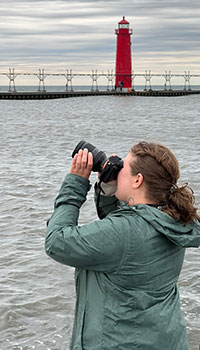 Stacie Skwarcan. Jackson School of Geosciences, The University of Texas at Austin, Austin, Texas 78712, USA. sskwarca@utexas.edu
Stacie Skwarcan. Jackson School of Geosciences, The University of Texas at Austin, Austin, Texas 78712, USA. sskwarca@utexas.edu
Stacie Skwarcan received bachelor’s degrees in Environmental Earth Sciences and Art Studio from the University of Notre Dame in 2018. She is currently a graduate student in the Jackson School of Geosciences at The University of Texas at Austin.
![]()
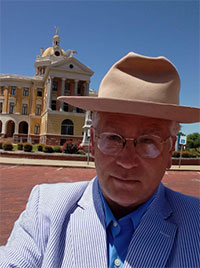 William Godwin. Sam Houston State Natural History Collections, Sam Houston State University, Huntsville, Texas 77341, USA. wbg004@shsu.edu
William Godwin. Sam Houston State Natural History Collections, Sam Houston State University, Huntsville, Texas 77341, USA. wbg004@shsu.edu
William Godwin PhD. Entomology Texas A&M University 2002. BS Biology/Journalism Stephen F. Austin State University 1992. Curator of Sam Houston State University Natural History Museum since 2016. Developed first institutional paleontology collection at SHSU with Patrick Lewis. Native Texan; First excavated McFaddin Beach in 1971 with a tiny plastic pail and shovel; 40 years of building relationships with all types of natural history investigators. Used these skills to build teams of private collections of McFaddin Beach specimens with scientific partners and institutional collections to promote the first scientific pubications of McFaddin Beach Pleistocene vertebrates.
![]()
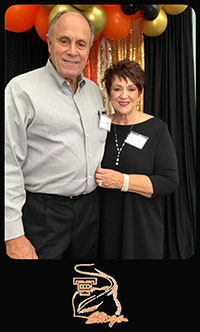 Jesse Fremont. Sam Houston State Natural History Collections, Sam Houston State University, Huntsville, Texas 77341, USA. jessefremont@msn.com
Jesse Fremont. Sam Houston State Natural History Collections, Sam Houston State University, Huntsville, Texas 77341, USA. jessefremont@msn.com
Jesse Fremont graduated from Texas City High School in 1967 before attending Lamar University. In 1972 he earned a Bachelor of Science Degree in Composite Science. He was a Chemistry and Physics teacher for 35 years for the Orangefield Independent School District in Orangefield, Texas. After retirement in 2007, he became the curator of the Orangefield Cormier Museum in Orangefield, Texas. He is an avid collector of fossils and artifacts. Some of his artifacts were mentioned in various science publications. He is married to his wife, Debbie, and has two married daughters, three grandsons and one great grandson.
![]()
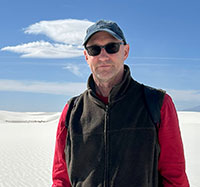 Patrick J. Lewis. Sam Houston State Natural History Collections, Sam Houston State University, Huntsville, Texas 77341, USA and Department of Biological Sciences, Sam Houston State University, Huntsville, Texas 77341, USA. pjl001@shsu.edu
Patrick J. Lewis. Sam Houston State Natural History Collections, Sam Houston State University, Huntsville, Texas 77341, USA and Department of Biological Sciences, Sam Houston State University, Huntsville, Texas 77341, USA. pjl001@shsu.edu
Patrick Lewis received his bachelor's (BA) in anthropology and his masters (MS) in interdisciplinary studies from Texas Tech University. He received his PhD from Duke University in 2003 where he worked on various small mammal assemblages from southern Africa, and the evolution of North American bison. He started at Sam Houston State in 2006, where he is now a Professor of Biological Sciences and the Associate Dean of the Honors College. He researches morphological change in various groups of vertebrates from several periods and areas, primarily mammals from the Plio-Pleistocene.

